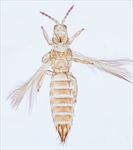
Female

Female

Antenna

Head

Head & pronotum

Pronotum

Meso & metanotum

Tergites V–VI

Tergites VIII–IX

Sternites VI–VII
Distinguishing features
Female macroptera. Body and legs yellow to white, distal antennal segments light brown, IV-VI yellow at base; fore wings pale. Antennae 7-segmented. Head transverse; ocellar setae III arise just within anterolateral margins of ocellar triangle close to first ocellus, ocellar region with weak transverse striae; postocular setae in straight row, subequal in size. Pronotum with transverse striae, 20–30 discal setae and 4–5 posteromarginal setae, external postero-angular seta shorter than inner seta. Metanotum irregularly reticulate medially, median setae well behind anterior margin, campaniform sensilla present. Fore wing first vein usually with 3 setae on distal half; clavus with terminal seta longer than subterminal seta. Abdominal tergite II with 3 lateral marginal setae; tergite VIII comb represented by a few teeth laterally. Sternite II with 1 or 2 discal setae, III–VII with 15–25 discal setae in an irregular transverse row; pleurotergites with no discal setae.
Male macroptera. Body yellow, sternites III–VII with 9–15 discal setae in an irregular transverse row posterior to small transverse pore plate.
Related species
Thrips safrus is sister-species to T. imaginis, with which it used to be confused. These two appear to be closely related to T. unispinus and possibly also to T. australis, although molecular data are needed in order to confirm the available morphological evidence. There are 33 species of Thrips genus known from Australia (Mound & Masumoto, 2005), out of a total of 296 species worldwide (ThripsWiki, 2020). Many of these species have the antennae clearly 7-segmented, whereas others have 8 segments. Some species have two complete rows of setae on the fore wing veins, whereas others have the setal row on the first vein more or less widely interrupted. Moreover, some species have sternal discal setae, whereas other species have only marginal setae on the sternites. Despite this variation, all members of Thrips genus have paired ctenidia on the tergites, and on tergite VIII these are postero-mesad to the spiracles, and they also lack ocellar setae pair I in front of the first ocellus. In contrast, Frankliniella species have ctenidia on tergite VIII antero-lateral to the spiracles, and a pair of setae is always present in front of the first ocellus.
Biological data
Feeding and breeding in the flowers of many plant species, with no obvious preferences.
Distribution data
Northern Australia, New Caledonia, and Hawaiian Islands (Mound et al., 2017).
Family name
THRIPIDAE - THRIPINAE
Species name
Thrips safrus Mound & Masumoto
Original name and synonyms
Thrips safrus Mound & Masumoto, 2005: 45.
References
Mound LA & Masumoto M (2005) The genus Thrips (Thysanoptera, Thripidae) in Australia, New Caledonia and New Zealand. Zootaxa 1020: 1–64. http://www.mapress.com/zootaxa/2005f/zt01020p064.pdf
Mound LA, Matsunaga J, Bushe B, Hoddle MS & Wells A (2017) Adventive Thysanoptera Species on the Hawaiian Islands: New Records and Putative Host Associations. Proceedings of the Hawaiian Entomological Society 49: 17–28.